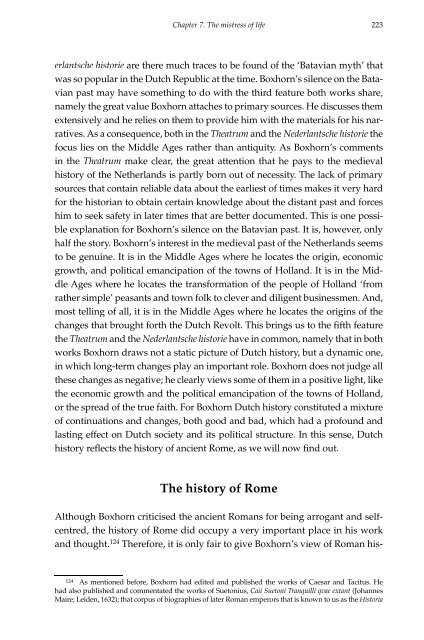historical and political thought in the seventeenth - RePub - Erasmus ...
historical and political thought in the seventeenth - RePub - Erasmus ...
historical and political thought in the seventeenth - RePub - Erasmus ...
You also want an ePaper? Increase the reach of your titles
YUMPU automatically turns print PDFs into web optimized ePapers that Google loves.
Chapter 7. The mistress of life<br />
erlantsche historie are <strong>the</strong>re much traces to be found of <strong>the</strong> ‘Batavian myth’ that<br />
was so popular <strong>in</strong> <strong>the</strong> Dutch Republic at <strong>the</strong> time. Boxhorn’s silence on <strong>the</strong> Batavian<br />
past may have someth<strong>in</strong>g to do with <strong>the</strong> third feature both works share,<br />
namely <strong>the</strong> great value Boxhorn attaches to primary sources. He discusses <strong>the</strong>m<br />
extensively <strong>and</strong> he relies on <strong>the</strong>m to provide him with <strong>the</strong> materials for his narratives.<br />
As a consequence, both <strong>in</strong> <strong>the</strong> Theatrum <strong>and</strong> <strong>the</strong> Nederlantsche historie <strong>the</strong><br />
focus lies on <strong>the</strong> Middle Ages ra<strong>the</strong>r than antiquity. As Boxhorn’s comments<br />
<strong>in</strong> <strong>the</strong> Theatrum make clear, <strong>the</strong> great attention that he pays to <strong>the</strong> medieval<br />
history of <strong>the</strong> Ne<strong>the</strong>rl<strong>and</strong>s is partly born out of necessity. The lack of primary<br />
sources that conta<strong>in</strong> reliable data about <strong>the</strong> earliest of times makes it very hard<br />
for <strong>the</strong> historian to obta<strong>in</strong> certa<strong>in</strong> knowledge about <strong>the</strong> distant past <strong>and</strong> forces<br />
him to seek safety <strong>in</strong> later times that are better documented. This is one possible<br />
explanation for Boxhorn’s silence on <strong>the</strong> Batavian past. It is, however, only<br />
half <strong>the</strong> story. Boxhorn’s <strong>in</strong>terest <strong>in</strong> <strong>the</strong> medieval past of <strong>the</strong> Ne<strong>the</strong>rl<strong>and</strong>s seems<br />
to be genu<strong>in</strong>e. It is <strong>in</strong> <strong>the</strong> Middle Ages where he locates <strong>the</strong> orig<strong>in</strong>, economic<br />
growth, <strong>and</strong> <strong>political</strong> emancipation of <strong>the</strong> towns of Holl<strong>and</strong>. It is <strong>in</strong> <strong>the</strong> Middle<br />
Ages where he locates <strong>the</strong> transformation of <strong>the</strong> people of Holl<strong>and</strong> ‘from<br />
ra<strong>the</strong>r simple’ peasants <strong>and</strong> town folk to clever <strong>and</strong> diligent bus<strong>in</strong>essmen. And,<br />
most tell<strong>in</strong>g of all, it is <strong>in</strong> <strong>the</strong> Middle Ages where he locates <strong>the</strong> orig<strong>in</strong>s of <strong>the</strong><br />
changes that brought forth <strong>the</strong> Dutch Revolt. This br<strong>in</strong>gs us to <strong>the</strong> fifth feature<br />
<strong>the</strong> Theatrum <strong>and</strong> <strong>the</strong> Nederlantsche historie have <strong>in</strong> common, namely that <strong>in</strong> both<br />
works Boxhorn draws not a static picture of Dutch history, but a dynamic one,<br />
<strong>in</strong> which long-term changes play an important role. Boxhorn does not judge all<br />
<strong>the</strong>se changes as negative; he clearly views some of <strong>the</strong>m <strong>in</strong> a positive light, like<br />
<strong>the</strong> economic growth <strong>and</strong> <strong>the</strong> <strong>political</strong> emancipation of <strong>the</strong> towns of Holl<strong>and</strong>,<br />
or <strong>the</strong> spread of <strong>the</strong> true faith. For Boxhorn Dutch history constituted a mixture<br />
of cont<strong>in</strong>uations <strong>and</strong> changes, both good <strong>and</strong> bad, which had a profound <strong>and</strong><br />
last<strong>in</strong>g effect on Dutch society <strong>and</strong> its <strong>political</strong> structure. In this sense, Dutch<br />
history reflects <strong>the</strong> history of ancient Rome, as we will now f<strong>in</strong>d out.<br />
The history of Rome<br />
Although Boxhorn criticised <strong>the</strong> ancient Romans for be<strong>in</strong>g arrogant <strong>and</strong> selfcentred,<br />
<strong>the</strong> history of Rome did occupy a very important place <strong>in</strong> his work<br />
<strong>and</strong> <strong>thought</strong>. 124 Therefore, it is only fair to give Boxhorn’s view of Roman his-<br />
124 As mentioned before, Boxhorn had edited <strong>and</strong> published <strong>the</strong> works of Caesar <strong>and</strong> Tacitus. He<br />
had also published <strong>and</strong> commentated <strong>the</strong> works of Suetonius, Caii Suetoni Tranquilli qvae extant (Johannes<br />
Maire; Leiden, 1632); that corpus of biographies of later Roman emperors that is known to us as <strong>the</strong> Historia<br />
223

















